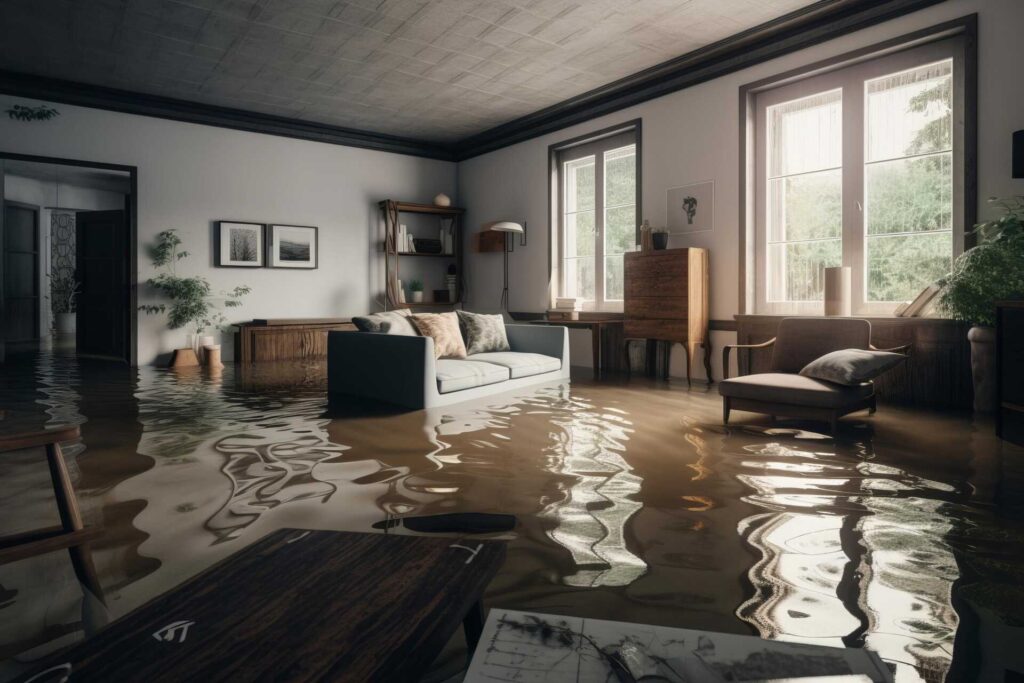
Contents
Did you know that mold can start growing within just 24 to 48 hours after water damage occurs? This rapid development highlights the urgency of addressing water intrusion immediately. Delaying action increases health risks and escalates repair costs due to structural deterioration. Understanding effective water removal strategies is essential in mitigating these dangers. What steps can you take to ensure a safe living environment and prevent long-term issues?
Key Takeaways
- Delaying water removal can lead to mold growth within 24 to 48 hours, increasing health risks for occupants.
- Structural integrity diminishes as materials like drywall and flooring become compromised over time.
- Contaminants proliferate in stagnant water, creating potential biohazards and escalating health concerns.
- Prompt action minimizes costly repairs and medical expenses associated with exposure to mold and contaminants.
- Regular inspections and immediate response to water intrusion are crucial for preventing long-term damage and ensuring safety.
Understanding the Risks of Delayed Water Removal
When you delay water removal after a flood or leak, you’re not just risking property damage; you’re opening the door to a host of health hazards.
A thorough risk assessment reveals that mold can begin to develop within 24 to 48 hours, dramatically increasing health risks such as respiratory issues and allergic reactions. The damage timeline accelerates, as structural integrity declines and materials like drywall and flooring become compromised.
As water sits, contaminants can proliferate, leading to potential biohazards. If you wait too long, you may find yourself facing costly repairs and medical expenses due to health complications.
Essential Tools for Effective Water Extraction
To effectively tackle water extraction, having the right tools at your disposal is essential. Water pumps are a critical component in this process. They come in various types, including submersible and utility pumps, each designed for specific conditions.
Submersible pumps are ideal for deep water removal, while utility pumps excel in shallow areas.
Alongside water pumps, extraction equipment plays an important role in ensuring thorough removal. This includes wet/dry vacuums and dehumidifiers, which help eliminate residual moisture and prevent mold growth.
Wet/dry vacuums can efficiently handle both water and debris, making them versatile for various situations.
Identifying the Source of Water Intrusion
How can you effectively identify the source of water intrusion in your property? Start by examining common moisture sources. Look for visible signs of water entry, like damp spots or mold growth. Inspect your roof, gutters, and downspouts for clogs or damage, as these can lead to significant leaks.
Use the table below to help identify potential sources of water intrusion:
| Moisture Source | Signs to Look For |
|---|---|
| Roof Leaks | Stains on ceilings; sagging roofs |
| Foundation Cracks | Water pooling around the foundation |
| Plumbing Issues | Unexplained water bill increases; damp walls |
| Window Seals | Water is pooling around the foundation |
| Basement/ Crawl Space Moisture | Musty odors; visible water lines |
Safety Precautions During Water Removal
Identifying the source of water intrusion is just the first step; ensuring safety during the removal process is equally important.
Without taking proper precautions, you risk injury or further damage. Here’s a checklist to keep in mind:
Wear safety gear: Use gloves, goggles, and waterproof boots to protect yourself from contaminants.
Disconnect power sources: Turn off electricity in affected areas to prevent electrocution and equipment damage.
Ventilate the area: Open windows and doors to reduce humidity and prevent mold growth during the removal process.
Follow emergency procedures: Have a plan in place for unexpected situations, such as electrical hazards or structural instability.
Steps to Take Immediately After Water Damage
After you experience water damage, the first step is to assess the extent of the damage thoroughly.
This evaluation will help you identify affected areas and prioritize your response.
Once you have a clear picture, begin water extraction immediately to mitigate further issues like mold growth and structural damage.
Assess the Damage
Water damage can wreak havoc in a home, so evaluating the situation promptly is crucial.
Start with a thorough damage assessment to identify the extent of the problem. Here’s a step-by-step approach for effective moisture evaluation:
Inspect the Source: Determine where the water came from—whether a leak, flood, or overflow.
Check Affected Areas: Examine walls, floors, and ceilings for discoloration or warping, indicating moisture intrusion.
Assess Belongings: Look through personal items, furniture, and appliances for damage or contamination.
Measure Humidity Levels: Use a hygrometer to check the moisture levels in the air, as high humidity can lead to mold growth.
Taking these steps ensures you have a clear understanding of the damage and can plan your next moves effectively.
Begin Water Extraction
Immediately begin the water extraction process to minimize further damage and reduce the risk of mold growth.
Your initial response is vital; using a wet/dry vacuum or a pump, remove standing water as quickly as possible. Focus on high-traffic areas first, as these are more susceptible to additional damage.
Make sure you wear protective gear, including gloves and masks, to safeguard against contaminants.
Once water is removed, use fans and dehumidifiers to dry out remaining moisture effectively.
Keep in mind that even small amounts of water can lead to mold within 24-48 hours, so acting promptly is essential.
Document the damage for insurance purposes, but prioritize extraction to protect your property and health.
The Importance of Professional Water Removal Services
When facing water damage, you might underestimate the complexities involved in effective removal, but relying on professional services can greatly mitigate long-term issues.
Professional expertise ensures that you’re removing water and addressing underlying problems.
Here are four reasons why a timely response from experts is essential:
Thorough Assessment: Professionals evaluate the extent of damage and identify hidden water sources.
Advanced Equipment: They use specialized tools for efficient extraction and drying, reducing the potential for mold.
Safety Protocols: Experts know how to handle hazardous materials that may arise from water damage, protecting your health.
Comprehensive Restoration: They provide a plan for restoration, addressing both visible and invisible damage to prevent future issues.
Preventing Mold Growth Post-Water Damage
To effectively prevent mold growth after water damage, you need to implement immediate drying techniques, utilize mold-resistant materials, and conduct regular inspections.
These steps minimize moisture and create an environment less conducive to mold proliferation.
Immediate Drying Techniques
If not addressed promptly, water-soaked carpets can quickly become a breeding ground for mold. To prevent mold growth, you need to implement immediate drying techniques.
Here are four advanced techniques that can help:
Extract Water: Use a wet/dry vacuum to remove as much water as possible from the carpet.
Increase Airflow: Open windows and doors while using fans to circulate air, speeding up the drying process.
Dehumidify: Employ a dehumidifier to pull moisture from the air, reducing humidity levels conducive to mold growth.
Heat Application: Utilize space heaters to elevate the temperature, which aids in evaporation.
Mold-Resistant Materials
After addressing immediate drying techniques, the focus shifts to the materials used in your home, which can greatly impact mold growth after water damage.
Utilizing moisture-resistant materials is one of the most effective mold prevention techniques. For instance, fiberglass insulation, vinyl flooring, and cement board are less susceptible to mold compared to traditional wood and drywall. These materials resist moisture and inhibit mold spores from proliferating.
Additionally, choosing mold-resistant paints and sealants can create a barrier against moisture penetration. Implementing these material choices during renovations or repairs ensures that your home remains a safe environment post-water damage.
Regular Inspections and Maintenance
While immediate response to water damage is essential, regular inspections and maintenance play an equally important role in preventing mold growth.
By implementing preventive measures, you can considerably reduce the risk of mold thriving in your space. Aim for an inspection frequency of at least once every three months to catch potential moisture issues early.
Here are four key actions to include in your routine:
- Check HVAC systems for moisture accumulation.
- Inspect plumbing for leaks or wear.
- Examine walls and ceilings for discoloration or dampness.
- Monitor basements and crawl spaces for humidity levels.
These proactive steps can help maintain a healthy environment and minimize the chances of mold development after water damage.
Long-Term Solutions for Water Mitigation
As climate change intensifies and extreme weather events become more frequent, the need for long-term solutions to water mitigation has never been more pressing. Implementing sustainable drainage systems and water-resistant landscaping can greatly reduce flooding risks and enhance water management in your area.
| Solution | Benefits |
|---|---|
| Sustainable Drainage | Reduces runoff and improves water quality |
| Water Resistant Landscaping | Minimizes erosion and water damage |
| Rain Gardens | Enhances biodiversity and filtration |
You’ll want to reflect on native plants that thrive in wet conditions for your landscaping. These solutions help manage excess water and create resilient ecosystems. By investing in these long-term strategies, you can protect your property and contribute to a healthier environment. Remember, proactive measures today can prevent costly damages tomorrow.
Insurance Considerations for Water Damage Claims
Understanding the intricacies of insurance coverage for water damage claims is essential for homeowners, especially in regions prone to flooding.
When dealing with a water damage situation, consider these four key aspects of your policy coverage:
Type of Coverage: Know if you have actual cash value or replacement cost coverage.
Exclusions: Be aware of specific exclusions related to flooding or gradual leaks.
Claim Submission Process: Familiarize yourself with the necessary documentation and timing for filing your claim.
Limits and Deductibles: Understand your policy’s coverage limits and any deductibles that apply.
Navigating these elements is critical.
Prompt claim submission can notably affect your reimbursement, especially when acting quickly after water damage occurs.
Always consult with your insurance agent to ensure you’re adequately protected and informed about your policy details.
Wrap-Up
In the blink of an eye, a small leak can transform your home into a mold-infested jungle, with walls rotting like ancient ruins and air thick with health risks. Don’t let procrastination be your enemy; act swiftly to remove water and protect your space. Remember, every second counts. Seize the tools and knowledge at your disposal, or risk watching your sanctuary crumble into a disaster zone, all while your health and wallet pay the ultimate price.
Recent Posts
Why Use Proven Techniques for Water Damage Restoration?
When faced with water damage, you know that quick action is essential. Using proven techniques
5 Tips for Water Damage Restoration Success
When faced with water damage, it’s essential to act quickly and methodically. You’ll need to
Master Flood Recovery: Test Your Water Removal Skills
Many people underestimate the complexity of flood recovery, often thinking it’s just about removing water.
